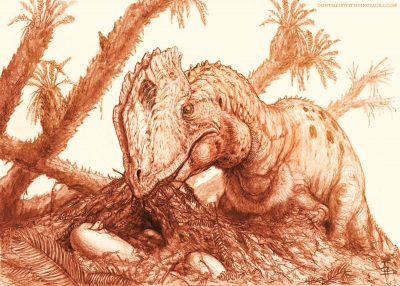No Frills for ‘Jurassic Park’ Dino
November 12, 2020

From movies to museum exhibits, the dinosaur Dilophosaurus is no stranger to pop culture. Many probably remember it best from the movie “Jurassic Park,” where it’s depicted as a venom-spitting beast with a rattling frill around its neck and two paddlelike crests on its head.
The dinosaur in the movie is mostly imagination, but a new comprehensive analysis of Dilophosaurus fossils is helping to set the record straight. Far from the small lizardlike dinosaur in the movies, the actual Dilophosaurus was the largest land animal of its time, reaching up to 20 feet in length. It also had much in common with modern birds. The analysis was published open access in the Journal of Paleontology on July 7, 2020. Dilophosaurus lived 183 million years ago during the Early Jurassic. Despite bigscreen fame, scientists knew surprisingly little about how the dinosaur looked or fit into a family tree, until now.
“It’s pretty much the best, worst-known dinosaur,” said lead author Adam Marsh. “Until this study, nobody knew what Dilophosaurus looked like or how it evolved.” Seeking answers to these questions, Marsh conducted an analysis of the five mostcomplete Dilophosaurus specimens while earning a Ph.D. at the Jackson School of Geosciences. He is now the lead paleontologist at Petrified Forest National Park. The analysis is co-authored by Professor Timothy Rowe, who discovered two of the five Dilophosaurus specimens that Marsh studied.
Early descriptions characterize the dinosaur as having a fragile dual crest and weak jaws, a description that influenced the depiction of Dilophosaurus in the “Jurassic Park” book and movie as a svelte dinosaur that subdued its prey with venom. But Marsh found the opposite. The jawbones show signs of serving as scaffolding for powerful muscles. He also found that some bones were mottled with air pockets, which would have helped reinforce the skeleton, including its crest.
Today, many species of birds use similar air sacs to inflate stretchy areas of skin. The intricate array of air pockets and ducts that extend from Dilophosaurus’ sinus cavity into its crests means that the dinosaur may have been able to perform similar feats with its headgear.
All the specimens Marsh examined came from the Kayenta Formation in Arizona and belong to the Navajo Nation. The University of California Museum of Paleontology holds in trust three of the specimens. The Jackson School Museum of Earth History holds the two discovered by Rowe.
Field work on the Navajo Nation was conducted under a permit from the Navajo Nation Minerals Department.
Back to the Newsletter